FAmesh: Generating Frequency Adaptive Meshes from Single Images under 2D Hole Constraints
Abstract
:1. Introduction
- We propose a framework for single-view mesh reconstruction that transitions from global to local, combining the advantages of MLP and GNN and mitigating the over-smoothing caused by deep GNN.
- We propose a new strategy for mesh pruning under the constraint of 2D holes that overcomes the limitation of the 0-genus template by combining hole contour information from 2D images to perform adaptive mesh topology correction.
- We facilitate fine-tuning of parts with different curvatures by separating the high- and low-frequency parts of the mesh and learning the corresponding mapping functions on the local extension patches of the high and low frequencies.
- We designed a series of experiments to demonstrate the superiority of the proposed method in topology correction and detail reconstruction over the existing methods.
2. Related Work
2.1. Implicit Function Representation
2.2. Voxel Representation
2.3. Point Cloud Representation
2.4. Mesh Representation
3. Method
3.1. Overview
3.2. Image Feature Extractor
3.3. Global Deformation Block
3.4. Pruning Module
3.5. Extend Patch Extract Module
3.6. Local Refinement Module
3.7. Loss Function
4. Result and Discussion
4.1. Experiment Settings
4.2. Comparisons with the State-of-the-Arts
4.3. Ablation Study
4.4. Comparison of Different Network Layers
4.5. Comparison between Basic Patch and Extended Patch
4.6. Comparison of Different Patches Size
4.7. Comparative Experiments on the Pix3D Dataset
5. Conclusions
Author Contributions
Funding
Institutional Review Board Statement
Informed Consent Statement
Data Availability Statement
Acknowledgments
Conflicts of Interest
References
- Chang, A.X.; Funkhouser, T.; Guibas, L.; Hanrahan, P.; Huang, Q.; Li, Z.; Savarese, S.; Savva, M.; Song, S.; Su, H.; et al. An information-rich 3d model repository. arXiv 2015, arXiv:1512.03012. [Google Scholar] [CrossRef]
- Sun, X.; Wu, J.; Zhang, X.; Zhang, Z.; Zhang, C.; Xue, T.; Tenenbaum, J.B.; Freeman, W.T. Pix3d: Dataset and methods for single-image 3d shape modeling. In Proceedings of the IEEE Conference on Computer Vision and Pattern Recognition, Salt Lake City, UT, USA, 18–22 June 2018; pp. 2974–2983. [Google Scholar] [CrossRef]
- Xiang, Y.; Mottaghi, R.; Savarese, S. Beyond pascal: A benchmark for 3d object detection in the wild. In Proceedings of the IEEE Winter Conference on Applications of Computer Vision, Steamboat Springs, CO, USA, 24–26 March 2014; pp. 75–82. [Google Scholar] [CrossRef]
- Chen, Z.; Zhang, H. Learning implicit fields for generative shape modeling. In Proceedings of the IEEE/CVF Conference on Computer Vision and Pattern Recognition, Long Beach, CA, USA, 16–17 June 2019; pp. 5939–5948. [Google Scholar] [CrossRef]
- Mescheder, L.; Oechsle, M.; Niemeyer, M.; Nowozin, S.; Geiger, A. Occupancy networks: Learning 3d reconstruction in function space. In Proceedings of the IEEE/CVF Conference on Computer Vision and Pattern Recognition, Long Beach, CA, USA, 16–17 June 2019; pp. 4460–4470. [Google Scholar] [CrossRef]
- Xu, Q.; Wang, W.; Ceylan, D.; Mech, R.; Neumann, U. Disn: Deep implicit surface network for high-quality single-view 3d reconstruction. In Proceedings of the 33rd International Conference on Neural Information Processing Systems, Vancouver, BC, Canada, 8–12 December 2019; pp. 492–502. [Google Scholar]
- Chen, Z.; Tagliasacchi, A.; Zhang, H. Bsp-net: Generating compact meshes via binary space partitioning. In Proceedings of the IEEE/CVF Conference on Computer Vision and Pattern Recognition, Seattle, WA, USA, 13–19 June 2020; pp. 45–54. [Google Scholar] [CrossRef]
- Choy, C.B.; Xu, D.; Gwak, J.; Chen, K.; Savarese, S. 3d-r2n2: A unified approach for single and multi-view 3d object reconstruction. In Proceedings of the European Conference on Computer Vision, Amsterdam, The Netherlands, 11–14 October 2016; pp. 628–644. [Google Scholar] [CrossRef]
- Tatarchenko, M.; Dosovitskiy, A.; Brox, T. Octree generating networks: Efficient convolutional architectures for high-resolution 3d outputs. In Proceedings of the IEEE International Conference on Computer Vision, Venice, Italy, 22–29 October 2017; pp. 2088–2096. [Google Scholar] [CrossRef]
- Tulsiani, S.; Zhou, T.; Efros, A.A.; Malik, J. Multi-view supervision for single-view reconstruction via differentiable ray consistency. In Proceedings of the IEEE Conference on Computer Vision and Pattern Recognition, Honolulu, HI, USA, 21–26 July 2017; pp. 2626–2634. [Google Scholar] [CrossRef]
- Wu, J.; Zhang, C.; Zhang, X.; Zhang, Z.; Freeman, W.T.; Tenenbaum, J.B. Learning shape priors for single-view 3d completion and reconstruction. In Proceedings of the European Conference on Computer Vision (ECCV), Munich, Germany, 8–14 September 2018; pp. 646–662. [Google Scholar] [CrossRef]
- Fan, H.; Su, H.; Guibas, L. A point set generation network for 3d object reconstruction from a single image. In Proceedings of the IEEE Conference on Computer Vision and Pattern Recognition, Honolulu, HI, USA, 21–26 July 2017; pp. 605–613. [Google Scholar] [CrossRef]
- Jiang, L.; Shi, S.; Qi, X.; Jia, J. Gal: Geometric adversarial loss for single-view 3d-object reconstruction. In Proceedings of the European Conference on Computer Vision (ECCV), Munich, Germany, 8–14 September 2018; pp. 802–816. [Google Scholar] [CrossRef]
- Zhao, M.; Xiong, G.; Zhou, M.; Shen, Z.; Wang, F.-Y. 3D-RVP: A method for 3D object reconstruction from a single depth view using voxel and point. Neurocomputing 2020, 430, 94–103. [Google Scholar] [CrossRef]
- Jack, D.; Pontes, J.K.; Sridharan, S.; Fookes, C.; Shirazi, S.; Maire, F.; Eriksson, A. Learning free-form deformations for 3d object reconstruction. In Proceedings of the Asian Conference on Computer Vision, Perth, Australia, 2–6 December 2018; pp. 317–333. [Google Scholar] [CrossRef]
- Wang, N.; Zhang, Y.; Li, Z.; Fu, Y.; Liu, W.; Jiang, Y.-G. Pixel2mesh: Generating 3d mesh models from single rgb images. In Proceedings of the European Conference on Computer Vision (ECCV), Munich, Germany, 8–14 September 2018; pp. 52–67. [Google Scholar] [CrossRef]
- Kanazawa, A.; Tulsiani, S.; Efros, A.A.; Malik, J. Learning category-specific mesh reconstruction from image collections. In Proceedings of the European Conference on Computer Vision (ECCV), Munich, Germany, 8–14 September 2018; pp. 371–386. [Google Scholar] [CrossRef]
- Pan, J.; Han, X.; Chen, W.; Tang, J.; Jia, K. Deep mesh reconstruction from single rgb images via topology modification networks. In Proceedings of the IEEE/CVF International Conference on Computer Vision, Seoul, Republic of Korea, 27 October–2 November 2019; pp. 9964–9973. [Google Scholar] [CrossRef]
- Smith, E.J.; Fujimoto, S.; Romero, A.; Meger, D. Geometrics: Exploiting geometric structure for graph-encoded objects. arXiv 2019, arXiv:1901.11461. [Google Scholar] [CrossRef]
- Tang, J.; Han, X.; Pan, J.; Jia, K.; Tong, X. A skeleton-bridged deep learning approach for generating meshes of complex topologies from single rgb images. In Proceedings of the IEEE/CVF Conference on Computer Vision and Pattern Recognition, Long Beach, CA, USA, 16–17 June 2019; pp. 4541–4550. [Google Scholar] [CrossRef]
- Shi, Y.; Ni, B.; Liu, J.; Rong, D.; Qian, Y.; Zhang, W. Geometric Granularity Aware Pixel-To-Mesh. In Proceedings of the IEEE/CVF International Conference on Computer Vision, Montreal, BC, Canada, 11–17 October 2021; pp. 13097–13106. [Google Scholar] [CrossRef]
- Yuan, Y.; Tang, J.; Zou, Z. Vanet: A view attention guided network for 3d reconstruction from single and multi-view images. In Proceedings of the 2021 IEEE International Conference on Multimedia and Expo (ICME), Shenzhen, China, 5–9 July 2021; pp. 1–6. [Google Scholar] [CrossRef]
- Zheng, X.; Jiang, B.; Zhang, J. Deformation representation based convolutional mesh autoencoder for 3D hand generation. Neurocomputing 2021, 444, 356–365. [Google Scholar] [CrossRef]
- Lorensen, W.E.; Cline, H.E. Marching cubes: A high resolution 3D surface construction algorithm. ACM SIGGRAPH Comput. Graph. 1987, 21, 163–169. [Google Scholar] [CrossRef]
- Armstrong, M.A. Basic Topology; Springer Science & Business Media: New York, NY, USA, 2013. [Google Scholar]
- Li, Q.; Han, Z.; Wu, X. Deeper insights into graph convolutional networks for semi-supervised learning. In Proceedings of the Thirty-Second AAAI Conference on Artificial Intelligence, New Orleans, LA, USA, 2–7 February 2018; pp. 3538–3545. [Google Scholar]
- Bo, D.; Wang, X.; Shi, C.; Shen, H. Beyond low-frequency information in graph convolutional networks. In Proceedings of the AAAI Conference on Artificial Intelligence, Hong Kong, China, 2–9 February 2021; pp. 3950–3957. [Google Scholar]
- Xie, H.; Yao, H.; Zhou, S.; Zhang, S.; Tong, X.; Sun, W. Toward 3d object reconstruction from stereo images. Neurocomputing 2021, 463, 444–453. [Google Scholar] [CrossRef]
- Wen, C.; Zhang, Y.; Li, Z.; Fu, Y. Pixel2mesh++: Multi-view 3d mesh generation via deformation. In Proceedings of the IEEE/CVF International Conference on Computer Vision, Seoul, Republic of Korea, 27 October–2 November 2019; pp. 1042–1051. [Google Scholar] [CrossRef]
- Hartley, R.; Zisserman, A. Multiple View Geometry in Computer Vision; Cambridge University Press: Cambridge, UK, 2003. [Google Scholar]
- Furukawa, Y.; Ponce, J. Accurate, Dense, and Robust Multiview Stereopsis. IEEE Trans. Pattern Anal. Mach. Intell. 2009, 32, 1362–1376. [Google Scholar] [CrossRef] [PubMed]
- Peng, B.; Wang, W.; Dong, J.; Tan, T. Learning pose-invariant 3D object reconstruction from single-view images. Neurocomputing 2020, 423, 407–418. [Google Scholar] [CrossRef]
- He, K.; Zhang, X.; Ren, S.; Sun, J. Deep residual learning for image recognition. In Proceedings of the IEEE Conference on Computer Vision and Pattern Recognition, Las Vegas, NV, USA, 27–30 June 2016; pp. 770–778. [Google Scholar] [CrossRef]
- Gkioxari, G.; Johnson, J.; Malik, J. Mesh r-cnn. In Proceedings of the IEEE/CVF International Conference on Computer Vision, Seoul, Republic of Korea, 27 October–2 November 2019; pp. 9785–9795. [Google Scholar] [CrossRef]
- Kipf, T.N.; Welling, M. Semi-supervised classification with graph convolutional networks. arXiv 2016, arXiv:1609.02907. [Google Scholar] [CrossRef]
- Veličković, P.; Cucurull, G.; Casanova, A.; Romero, A.; Lio, P.; Bengio, Y. Graph attention networks. arXiv 2017, arXiv:1710.10903. [Google Scholar] [CrossRef]
- Groueix, T.; Fisher, M.; Kim, V.G.; Russell, B.C.; Aubry, M. A papier-mâché approach to learning 3d surface generation. In Proceedings of the IEEE Conference on Computer Vision and Pattern Recognition, Salt Lake City, UT, USA, 18–22 June 2018; pp. 216–224. [Google Scholar] [CrossRef]
- Suzuki, S. Topological structural analysis of digitized binary images by border following. Comput. Vis. Graph. Image Process. 1985, 30, 32–46. [Google Scholar] [CrossRef]
- Loop, C. Smooth Subdivision Surfaces Based on Triangles. Master’s Thesis, University of Utah, Salt Lake City, UT, USA, 1987. [Google Scholar]
- Kato, H.; Ushiku, Y.; Harada, T. Neural 3d mesh renderer. In Proceedings of the IEEE Conference on Computer Vision and Pattern Recognition, Salt Lake City, UT, USA, 18–22 June 2018; pp. 3907–3916. [Google Scholar] [CrossRef]
- Kingma, D.P.; Ba, J. Adam: A method for stochastic optimization. arXiv 2014, arXiv:1412.6980. [Google Scholar] [CrossRef]
- Knapitsch, A.; Park, J.; Zhou, Q.; Koltun, V. Tanks and Temples: Benchmarking Large-Scale Scene Reconstruction. ACM Trans. Graph. 2017, 36, 78. [Google Scholar] [CrossRef]
- Chiang, W.-L.; Liu, X.; Si, S.; Li, Y.; Bengio, S.; Hsieh, C.-J. Cluster-gcn: An efficient algorithm for training deep and large graph convolutional networks. In Proceedings of the 25th ACM SIGKDD International Conference on Knowledge Discovery & Data Mining, Anchorage, AK, USA, 4–8 August 2019; pp. 257–266. [Google Scholar] [CrossRef]
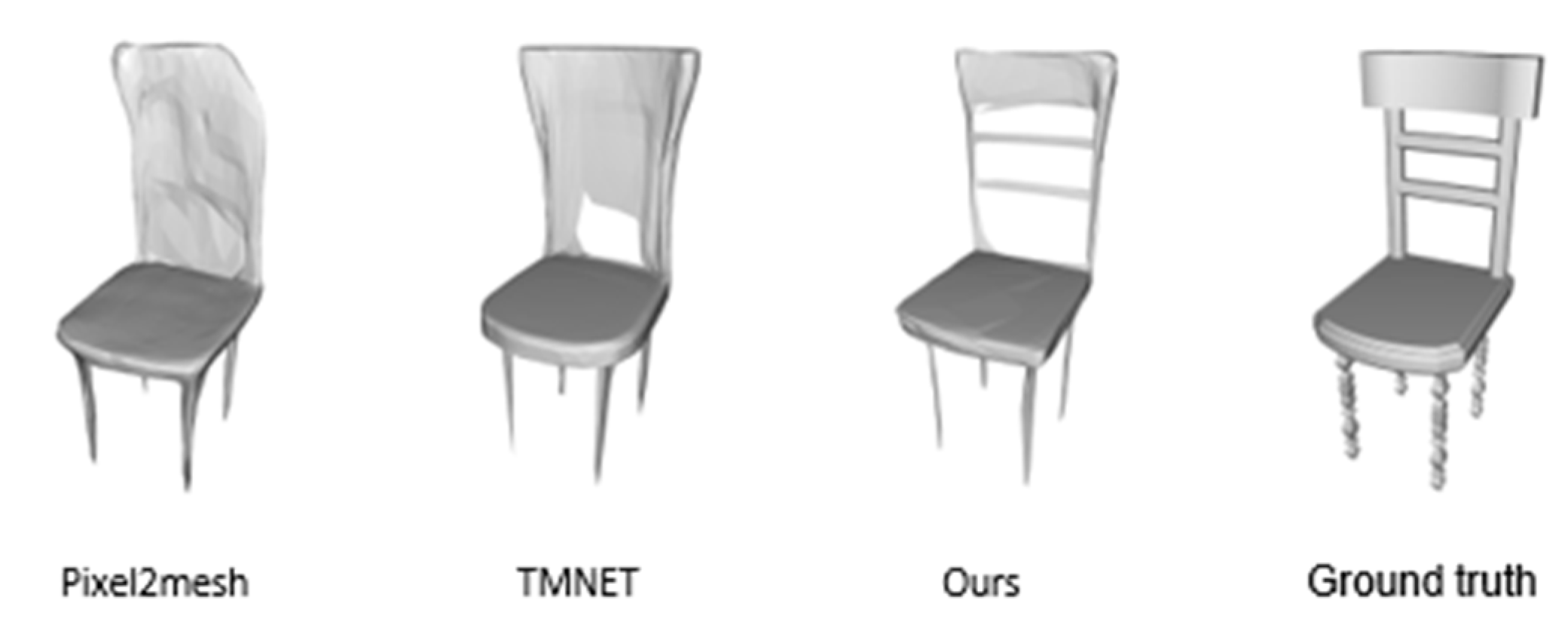

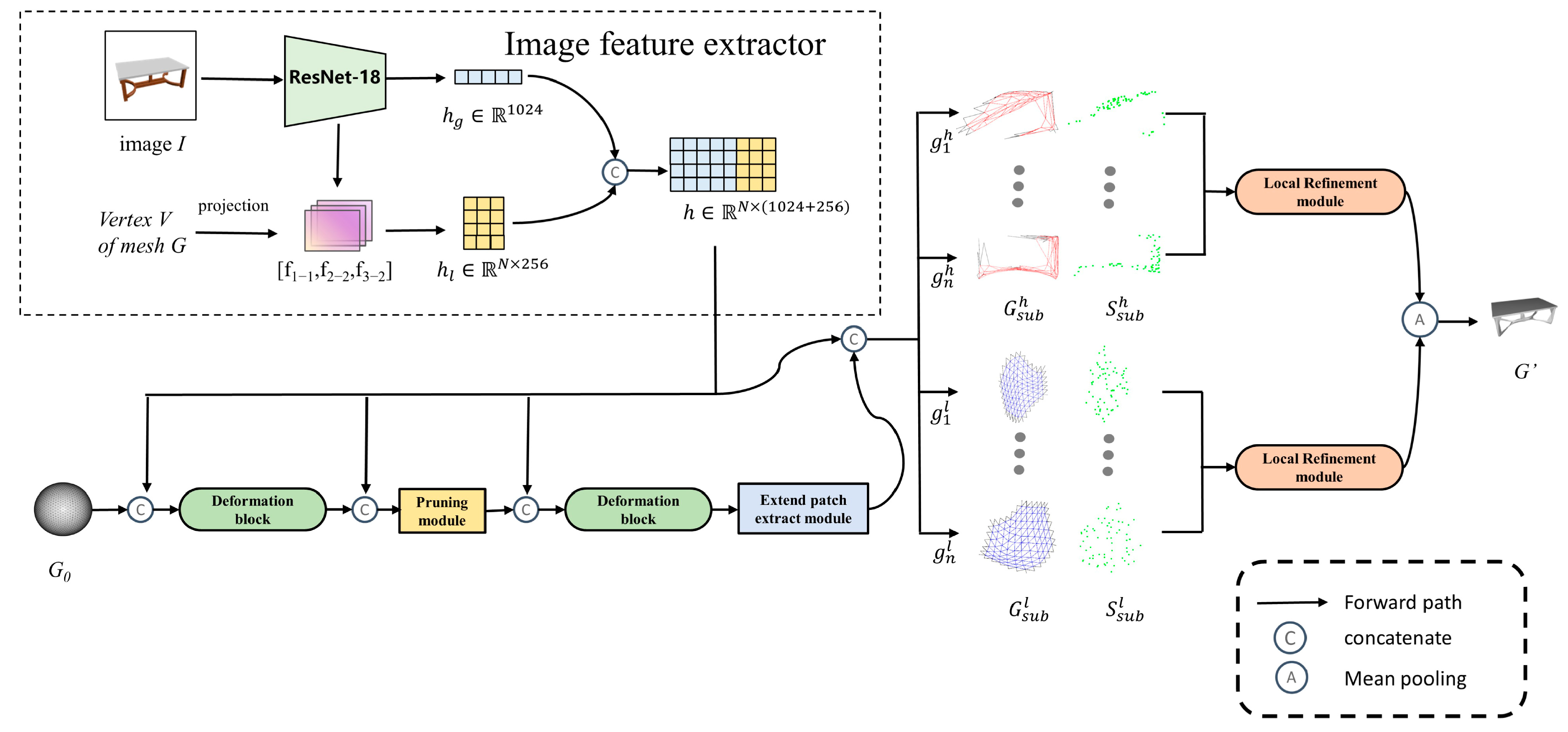
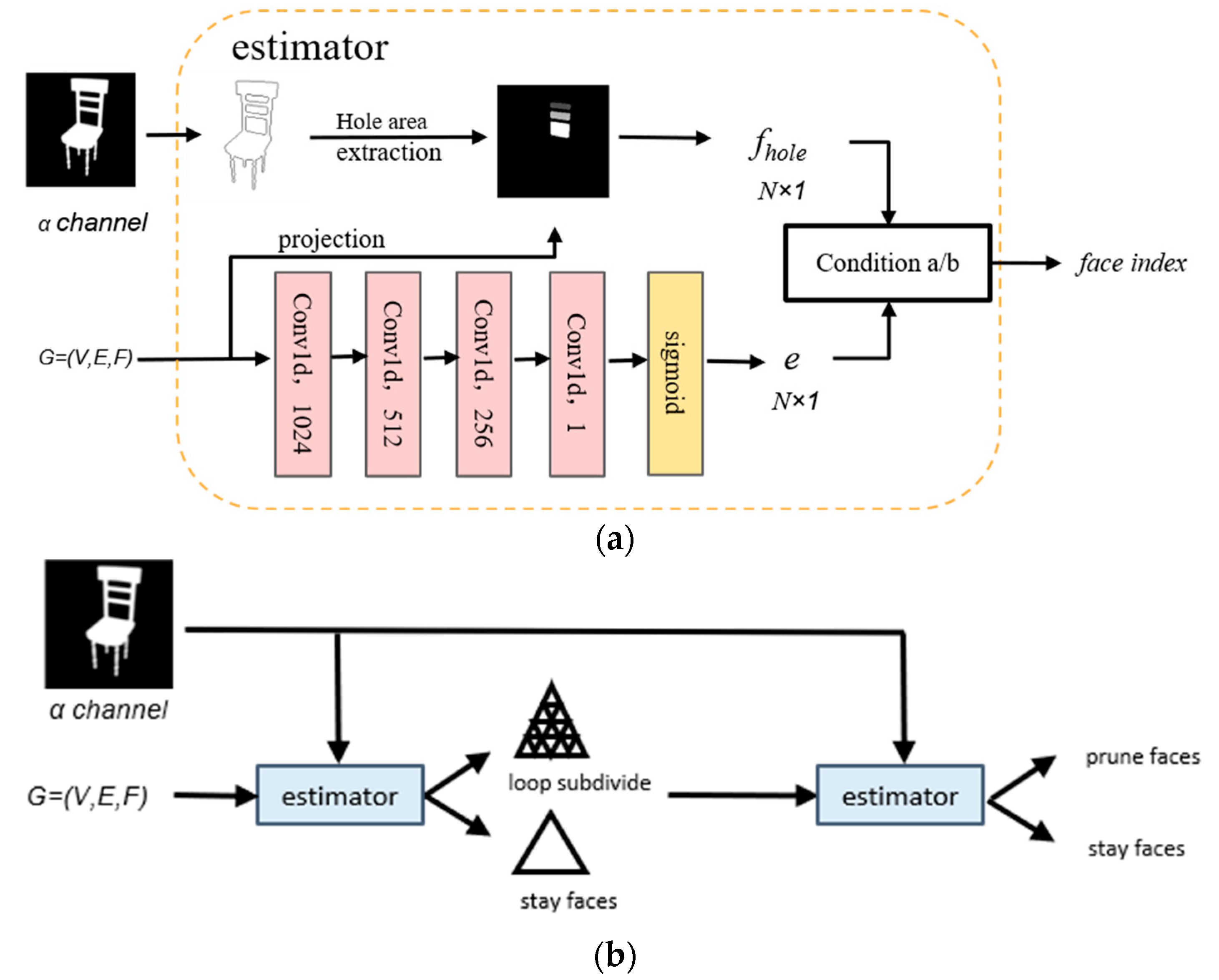


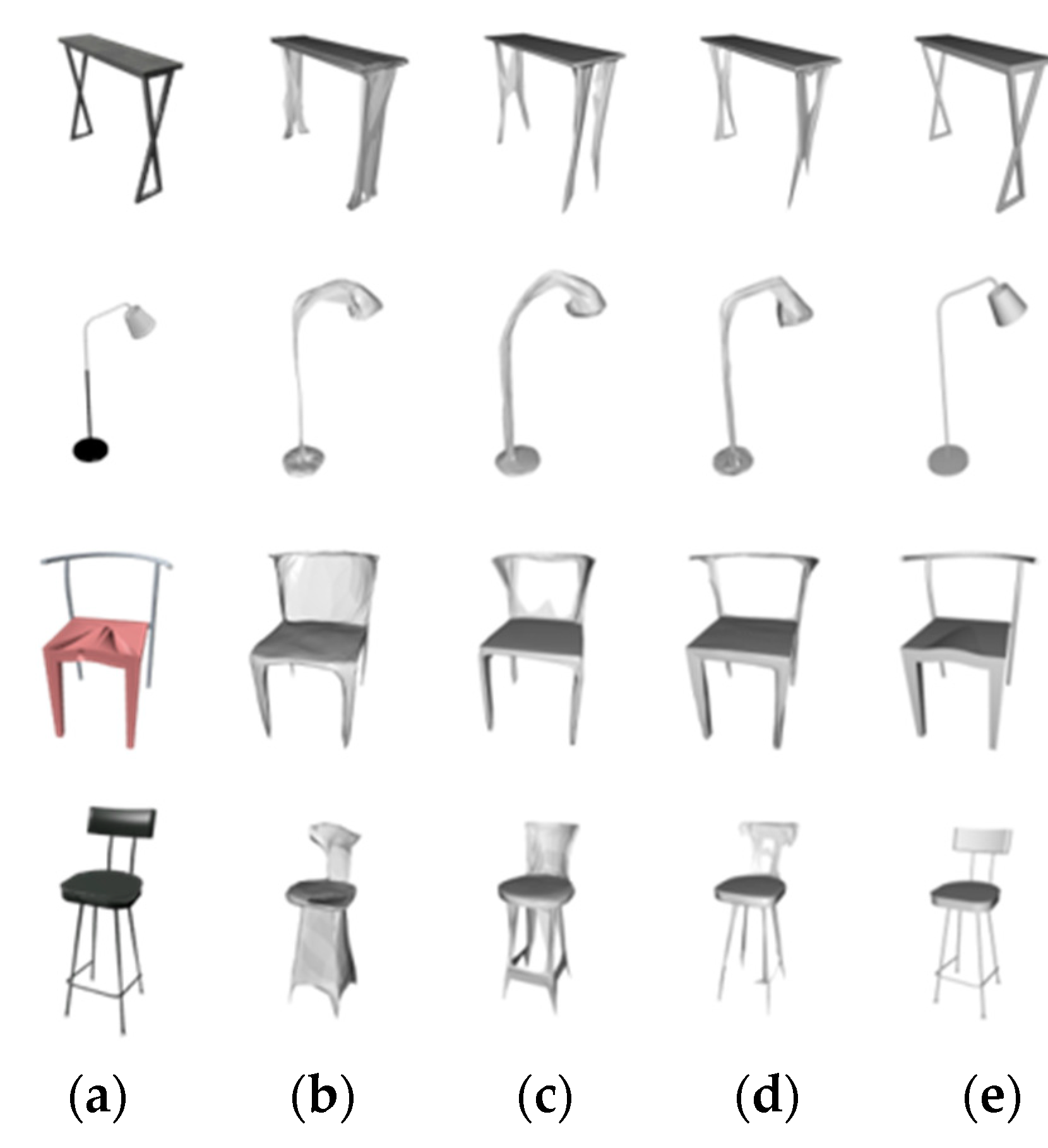

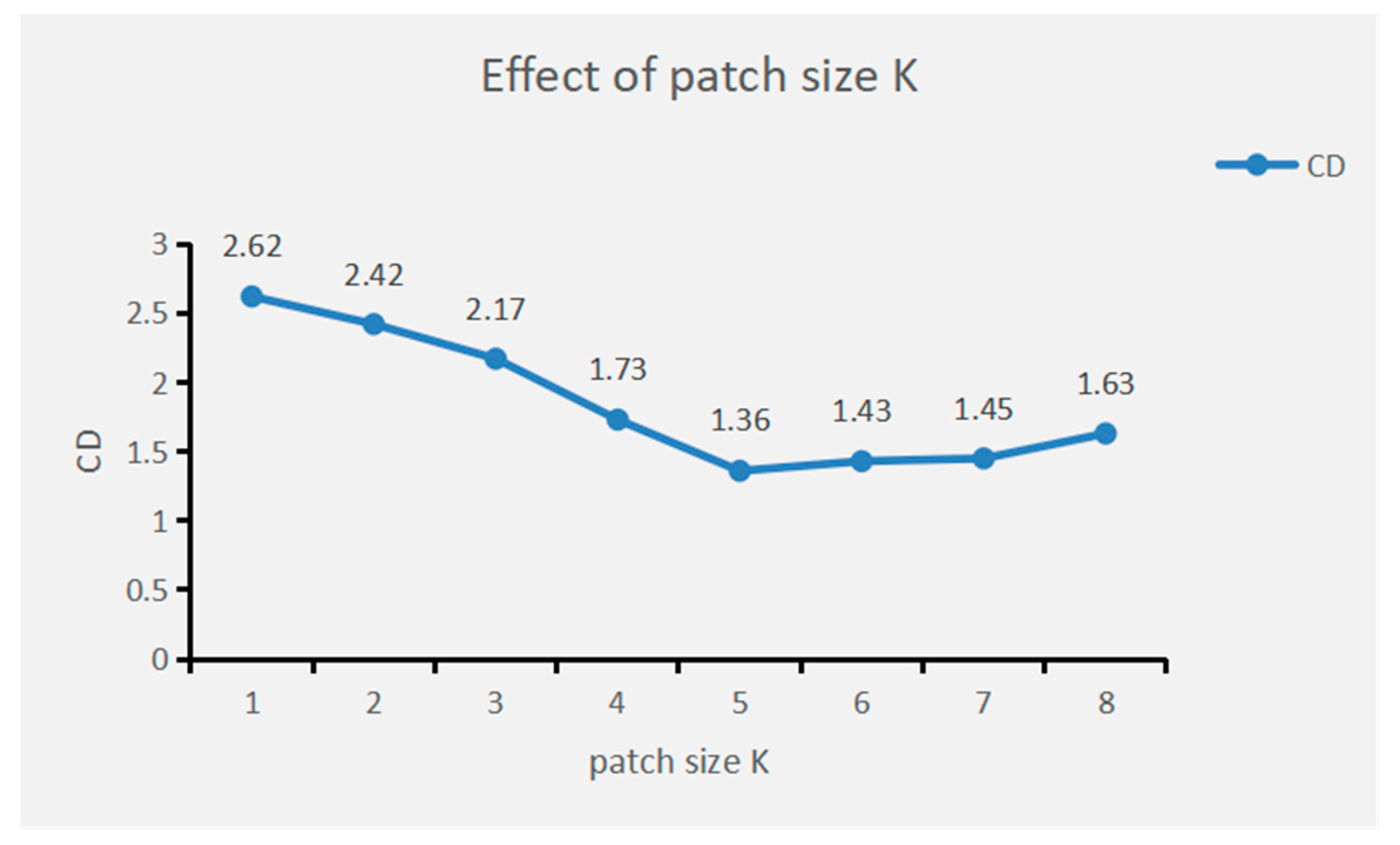
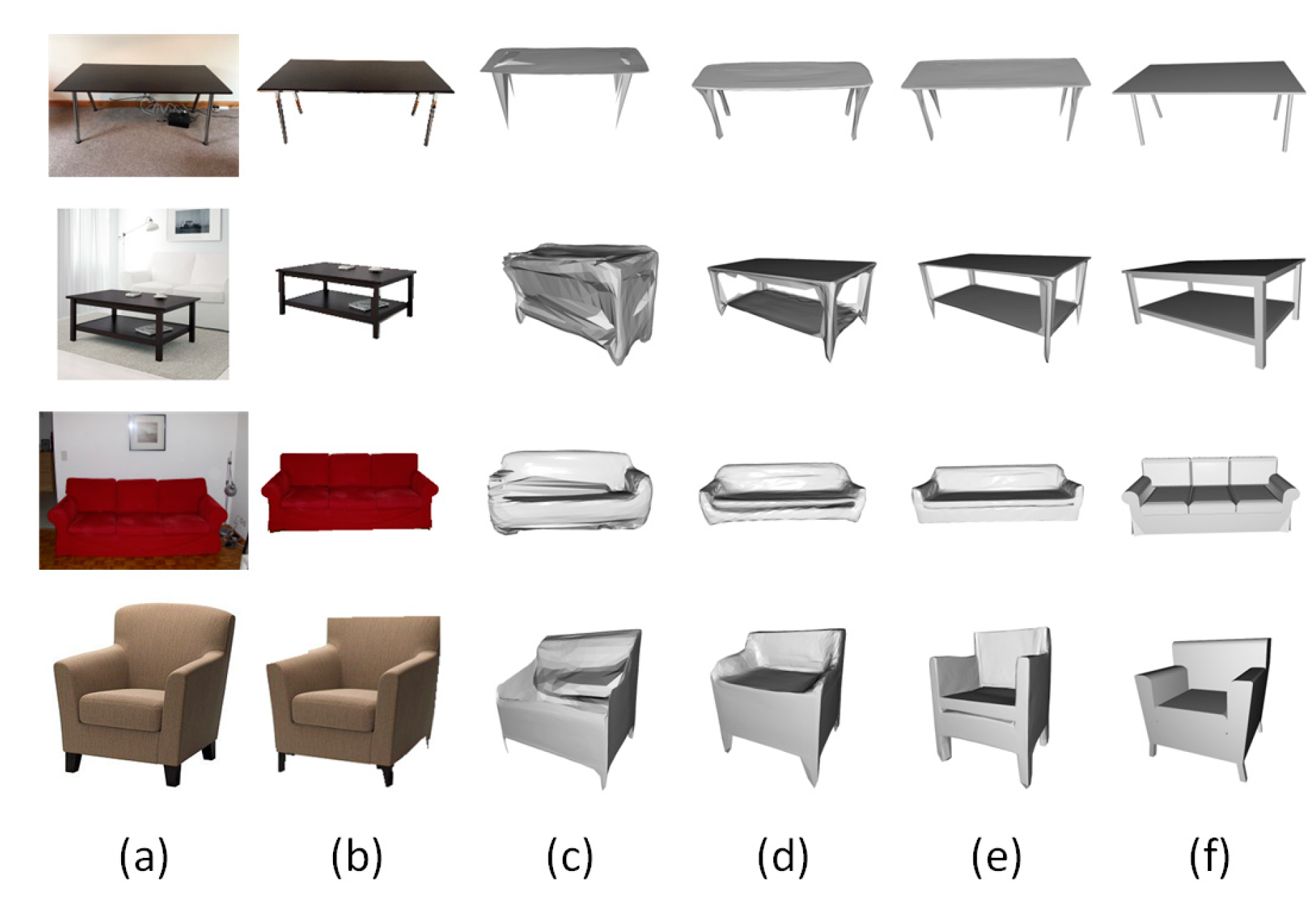
| Category | CD | F-Score | ||||||||||
|---|---|---|---|---|---|---|---|---|---|---|---|---|
| Pixel2mesh | Atlasnet | TMNET | Vanet | Ours | ∆ | Pixel2mesh | Atlasnet | TMNET | Vanet | Ours | ∆ | |
| plane | 2.547 | 1.539 | 1.325 | 2.317 | 0.912 | −0.413 | 76.93 | 89.45 | 87.79 | 79.31 | 93.78 | 5.99 |
| bench | 2.833 | 2.112 | 2.042 | 2.874 | 1.768 | −0.274 | 74.46 | 79.71 | 81.82 | 70.45 | 88.03 | 6.21 |
| cabinet | 2.394 | 2.168 | 1.823 | 2.651 | 1.817 | −0.006 | 78.17 | 79.47 | 79.10 | 76.74 | 80.53 | 1.43 |
| car | 2.035 | 2.427 | 1.592 | 2.789 | 1.092 | −0.500 | 82.74 | 83.14 | 88.49 | 83.47 | 90.43 | 1.94 |
| chair | 2.771 | 1.731 | 1.726 | 2.510 | 1.238 | −0.488 | 75.49 | 82.47 | 83.74 | 78.24 | 84.79 | 1.05 |
| monitor | 3.043 | 2.125 | 2.423 | 3.247 | 2.467 | 0.044 | 70.03 | 77.92 | 78.68 | 72.03 | 78.92 | 0.24 |
| lamp | 5.124 | 4.049 | 5.348 | 4.515 | 3.029 | −2.319 | 62.36 | 66.22 | 67.48 | 64.54 | 74.21 | 6.73 |
| speaker | 3.574 | 3.026 | 3.276 | 3.724 | 2.929 | −0.347 | 72.45 | 74.21 | 73.40 | 74.36 | 75.38 | 1.98 |
| firearm | 2.142 | 2.454 | 1.894 | 2.482 | 0.949 | −0.945 | 83.79 | 83.76 | 86.27 | 83.50 | 93.22 | 6.95 |
| couch | 2.357 | 1.938 | 1.295 | 2.677 | 1.594 | 0.299 | 80.14 | 84.06 | 87.23 | 82.37 | 87.33 | 0.10 |
| table | 5.809 | 2.742 | 2.416 | 5.939 | 1.832 | −0.584 | 65.48 | 79.47 | 81.63 | 67.64 | 86.65 | 5.02 |
| phone | 1.963 | 1.473 | 1.086 | 1.647 | 1.371 | 0.285 | 85.15 | 88.63 | 90.05 | 86.20 | 90.17 | 0.12 |
| vessel | 3.016 | 2.318 | 2.113 | 3.546 | 1.923 | −0.190 | 79.31 | 80.21 | 82.94 | 79.41 | 86.77 | 3.83 |
| mean | 3.047 | 2.316 | 2.181 | 3.148 | 1.763 | −0.418 | 75.88 | 80.67 | 82.20 | 76.79 | 85.40 | 3.20 |
| Category | Chamfer Distance | F-Score | ||||
|---|---|---|---|---|---|---|
| Full Model | Without Prune | Without Refine | Full Model | Without Prune | Without Refine | |
| With holes | 1.612 | 2.062 | 1.953 | 86.49 | 80.27 | 83.79 |
| With details | 1.967 | 2.041 | 2.426 | 84.73 | 85.14 | 80.46 |
| others | 1.740 | 1.852 | 2.075 | 85.22 | 84.96 | 81.51 |
| Mean | 1.763 | 1.944 | 2.128 | 85.40 | 83.91 | 81.79 |
| Item | Full Model | Without Prune | Without Refine |
|---|---|---|---|
| Time (ms) | 51.9 | 32.1 | 34.0 |
| Category | Chamfer Distance | F-Score | ||||
|---|---|---|---|---|---|---|
| MLP | GCN | FAGCN | MLP | GCN | FAGCN | |
| Mean | 2.207 | 1.987 | 1.763 | 80.85 | 81.23 | 85.40 |
Disclaimer/Publisher’s Note: The statements, opinions and data contained in all publications are solely those of the individual author(s) and contributor(s) and not of MDPI and/or the editor(s). MDPI and/or the editor(s) disclaim responsibility for any injury to people or property resulting from any ideas, methods, instructions or products referred to in the content. |
© 2023 by the authors. Licensee MDPI, Basel, Switzerland. This article is an open access article distributed under the terms and conditions of the Creative Commons Attribution (CC BY) license (https://creativecommons.org/licenses/by/4.0/).
Share and Cite
Wen, F.; Li, Q. FAmesh: Generating Frequency Adaptive Meshes from Single Images under 2D Hole Constraints. Appl. Sci. 2023, 13, 5995. https://doi.org/10.3390/app13105995
Wen F, Li Q. FAmesh: Generating Frequency Adaptive Meshes from Single Images under 2D Hole Constraints. Applied Sciences. 2023; 13(10):5995. https://doi.org/10.3390/app13105995
Chicago/Turabian StyleWen, Fanbiao, and Qingguang Li. 2023. "FAmesh: Generating Frequency Adaptive Meshes from Single Images under 2D Hole Constraints" Applied Sciences 13, no. 10: 5995. https://doi.org/10.3390/app13105995





